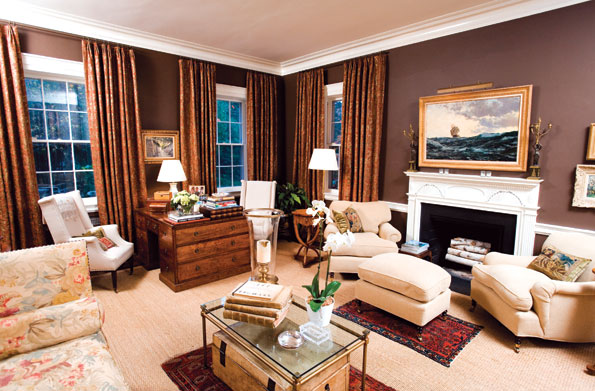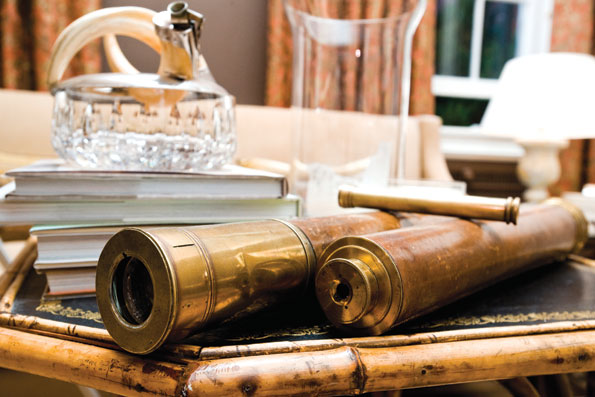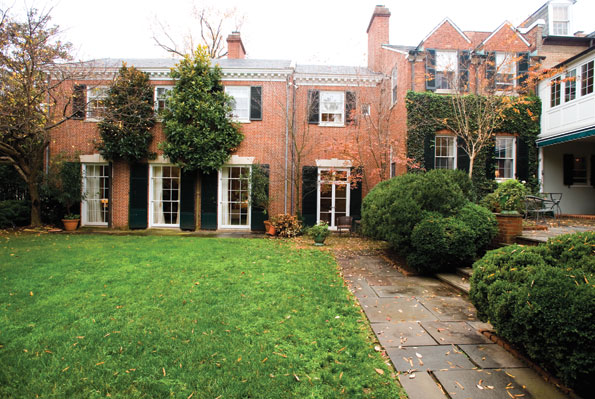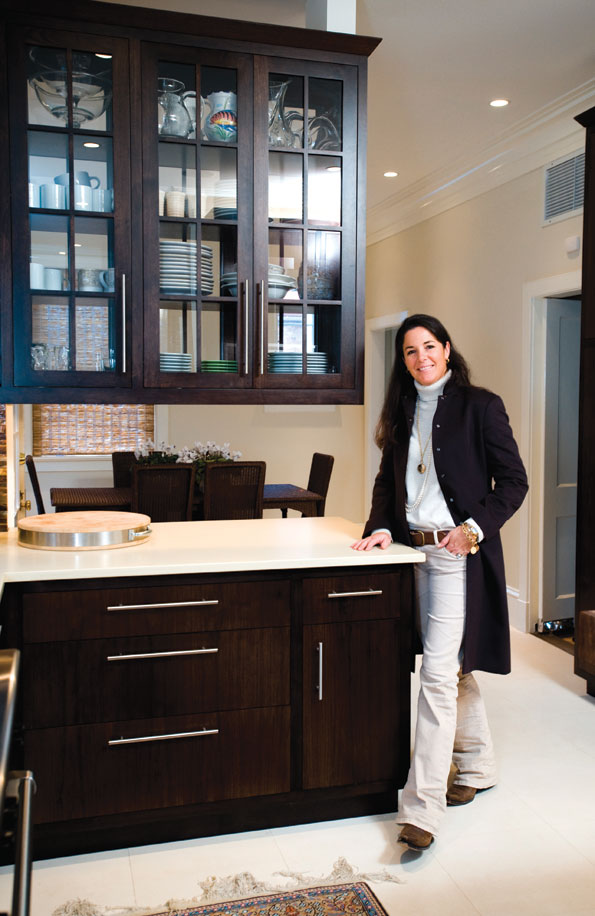
The sitting room’s rear windows offer a contemplative view of the award-winning garden designed by Rose Greely. The walnut desk, rolled arm chairs, and triumphant seascapes ensure an intimate atmosphere for a masculine retreat. Photo by Joseph Allen.
The couple was drawn to their home’s unique history and impeccable craftsmanship, some of the finest of its time. Built during the early 1800’s housing boom, which produced dwellings befitting the diplomats and officials streaming into the fledgling capital, and subsequently added to over the years, the Winsors’ residence has been owned by successive generations of prominent District families.
David K. E. Bruce, who served as U.S. ambassador to France, Great Britain, Germany, and China, and his wife, Evangeline, a fashionable international society doyenne, transformed the property into something of an unofficial embassy. The legendary couple not only filled it with the most interesting people of the day, but with a style of reminiscent of England’s most comfortable and well-appointed country houses. Each of their home’s many rooms was punctuated with interesting and valuable mementos of their diplomatic service and many travels throughout the world.

A collection of leather and bronze spyglasses subtly hints at the prized garden views just through the windows. Photo by Joseph Allen.
The basic structure and ambience remain unchanged since the completion of several expansions, the last of which took place in the late 1950s. The house retains its exquisite exterior facade, featuring Flemish bond brickwork, fluted keystones, and Aquia sandstone detailing. The expansive property includes a full guesthouse, a lap pool, and one of Georgetown’s most notable walled gardens.
Designed by famed landscape architect Rose Greely in 1955, this one-of-kind space features a stone terrace, lush sunken lawns, and delicate perimeter walks. As Deborah Winsor explains, “the garden was so well designed, there is always something blooming, whether it is white peonies or the white French tulips that we planted ourselves.”
The interiors have experienced the most dramatic changes. The cluttered, collected assemblages so popular in the past have given way to a more refined sensibility that maintains character and history while balancing the needs of a modern family.
Deborah Winsor, an interior designer, has created spaces that illustrate these principles perfectly, even where style varies from one room to the next. “The drawing room is mine and the sitting room is Curtin’s,” she notes, with the drawing room reflecting her more neutral style, and the sitting room his taste for an English country look. The grand drawing room is an exercise in muted natural tones, with smart tan woven carpeting and beige silk draperies offset against a slightly darker shaded wall. A cream-colored sofa and overstuffed chairs anchor half of the room while a corresponding set in rich dark velvet and warm mahogany create a separate seating area nearer to the room’s entrance.
These areas are tied together with punches of color from each of the separate palettes. The cream-colored furnishings are punctuated with rich brown leather ottomans and a magnificent gray velvet folding screen, purchased from the estate of Katharine Graham (a friend and frequent guest of the Bruces’). The room’s design not only reflects Deborah Winsor’s aesthetic vision, it also serves the family’s contemporary entertaining requirements. Its previous incarnation as a formal ballroom is suggested by an ornate gilt chandelier in the center of the room and a brilliantly framed portrait of a Czar Alexander II. The re-imagined space, however, has veered away from the needs of “politically-minded parties,” as Deborah Winsor puts it, to embrace a style of entertaining that “is more about enjoying time with our friends, family, and of course our children’s friends.”

The exterior façade of the Ambassador Bruce House is quintessential Georgetown. Photo by Joseph Allen.
A similar sensibility and casual elegance can be found in Curtin Winsor’s preferred haunt, the first floor sitting room, where saturated grays, browns, reds and greens mingle with lighter, neutral tones and simplicity mixes seamlessly with more formal elements such as the muted botanical print fabric on a George Smith sofa. An antique trunk and a streamlined bronze and glass piece serve double duty as a cocktail table, and traditional English wingback chairs have been transformed by coverings of masculine ivory cotton. The effect of a traditional gentleman’s study works equally well when the room is used during intimate cocktail receptions. The elegantbut- not-overly-serious style is a perfect fit for the couple’s entertaining philosophy, which Curtin Winsor sums up playfully with a self-coined aphorism: “If we haven’t broken any crystal, then we haven’t done enough to entertain our guests.”
Even the renovated kitchen, which could easily have lost its historical merit in favor of modern conveniences, features design elements that pay homage to the room’s original character. The walls feature exquisite hand blown glass tiles fashioned to resemble tortoise shell, a popular material in 19th century design, This is a lovely element that, as Deborah Winsor says, “tones down the modern elements of the cabinets and limestone floors” that “add a hint of character” themselves.
A sense of style is reflected in every room, not just through the use of color and major pieces of furniture, but also in the deliberate and intriguing use of antiques. “The architecture can speak for itself,” Deborah Winsor notes. “I love to let antiques and art bring in color and interest.” Indeed, a delightful hot air balloon basket purchased in Paris adds a touch of whimsy near the entrance to the drawing room. Treasured family heirlooms, including a letter signed by Abraham Lincoln, remind visitors of the wonderful history shared by the house and the nation’s capital.
“You should live in every room of your house,” Deborah Winsor says, and she and her family do that with grace and style. The interiors are elegant, understated, and intensely personal. Despite the changes that have been made over the years, it is evident that this historic landmark continues to embody the best traditions of Georgetown. It is comforting to know that it will continue to do so as long as the current owners call it home.





